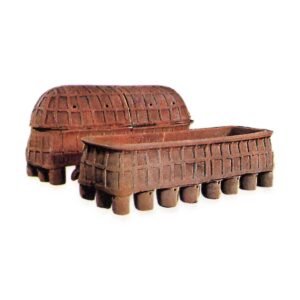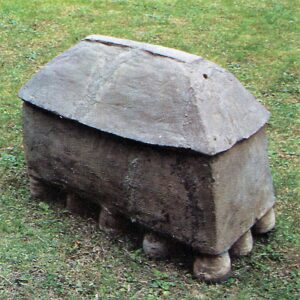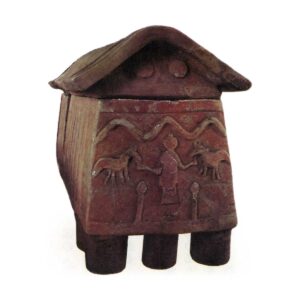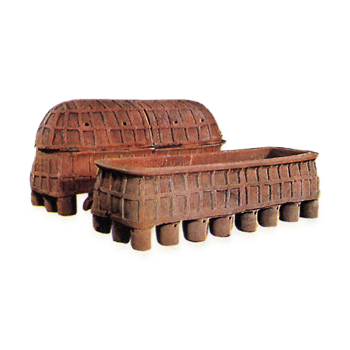


A type of clay coffin made by baking clay. Among clay coffins, those that trace their shape to everyday vessels, such as jar coffins for shaped earthenware, cylindrical coffins for those made of cylindrical haniwa clay or those thought to have changed shape from cylindrical haniwa clay, and pottery and large earthenware used for washing and cremation are customarily called kurakotsuki or urns, so the term “ceramic coffin” is used in a rather vague way, The term “ceramic coffin” is a rather vague name used to refer to clay coffins, the origin of which is difficult to find in other vessels used for burial. As a result, in most cases, it refers to coffins made by imitating the shape of wooden or sarcophagus coffins with clay. Whether the coffin is made of Sue or earthenware, it is called a ceramic coffin without regard to the firing technique. Pottery coffins have been found in many parts of the ancient world. The earliest example is a ceramic coffin from Ur in the middle of the third millennium B.C. In Mesopotamia, there are oval-shaped and house-shaped coffins and coffins with doll-shaped lids. In Crete, oval, oval, and house-shaped coffins were also used, and these coffins are characterized by paintings and geometric patterns, such as those depicting the “labrys” (double axes) and “sacred horns” unique to Crete. The Etruscan coffins were also used in ancient Greece, but the Etruscan coffins are famous for their three-dimensional representations of the dead on the top surface of the lid, and sometimes the whole body of the couple. The Roman period inherited this form. There are also box-shaped and doll-shaped ceramic coffins in Palestine, and near Madras, India, there is a known dolmen from the period around AD that contains a ceramic coffin with tubular legs. In China, a box-shaped ceramic coffin with a kamaboko-shaped lid dating from the Han to Western Jin periods has been found in a cliff tomb in Sichuan Province. This coffin is grayish-brown in color and is the same quality as the tile coffins of the Han dynasty, hence the Chinese term tile coffin. With the exception of a few examples, the ceramic coffins found in the various regions mentioned above were probably developed independently. Japanese ceramic coffins used from the late 6th to the 8th century are also thought to have been invented by the ancient Japanese. Japanese ceramic coffins were rectangular in shape with two or three rows of cylindrical legs, or rounded at both ends, and covered with a medium-high lid. In terms of firing techniques, there are two types of coffins: earthenware coffins and Sue or tiled coffins. The earliest earthenware coffins were those with a rounded, raised lid and a clay band attached horizontally and vertically to both the body and lid for reinforcement, and are called tortoise-shaped coffins because of their similarity in shape. The gable-roofed coffin appeared a little later. This type of coffin is known to have a short side of the body decorated with a human or horse figure in relief, or with eaves round tiles decorated with a kawaratotsu pattern. Many earthenware coffins are reddish brown in color, with the so-called “brush marks” left over from the finishing process, and the outer surface is often painted red with bengara. In large coffins, the body and lid are separated at the center, and the four parts are assembled together. Kilns for firing earthenware coffins have not yet been discovered.
Sue-quality ceramic coffins are called “Shijo style roof-shaped ceramic coffins” because the roof shape resembles the roof shape of the Shishu-zukuri style. Many of these coffins had small holes drilled in the slopes at both ends of the roof and were sealed with a disc. Some coffins were formed by pounding after piling up the pieces in a circle and others were formed by pounding them into a plate shape, leaving traces of the pounded mold on the interior and exterior surfaces. The first appearance of the four-note roof-shaped ceramic coffin seems to have preceded the gable-shaped ceramic coffin of earthenware. Ceramic coffins were mainly used in the Chugoku and Kinki regions, but there are many excavated examples in the eastern part of Okayama Prefecture. When cremation became popular, ceramic coffins were made in smaller sizes. There was also a small cylindrical coffin made of earthenware with a rounded end and no legs, which is called a cannonball-shaped ceramic coffin, but it is more similar to a cylindrical coffin.



